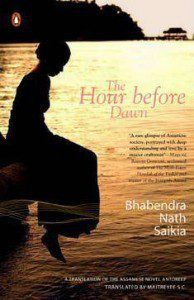“The Hour Before Dawn” and “Agnisnan”: A critical response to the English translation and the film adaptation of the Assamese novel “Antoreep”
In this paper I am discussing the Translation of Dr. Bhabendra Nath Saikia’s Assamese novel “Antoreep”[1] into English as “The Hour Before Dawn”[2] by Maitreyee Siddhanta Chakravarty and also the movie adaption of the first part of the novel as “Agnisnan”[3] by the writer himself.
Before diving into a detailed discussion of these ‘inter-lingual’ and ‘inter-semiotic’ translation practices I would like to place the source text into the context and give a brief background of the author.
Padmashri Bhabendra Nath Saikia occupies a prestigious place in the history of Assamese literature. This prolific writer’s large body of work includes different literary genres like short stories (many of which have been translated into English, Bengali, Hindi, Telugu, Malayalam, Marathi, Gujarati etc.), novels, plays, children literature, lyrics, films etc. all of which enjoy great appreciation from the readers. Dr. Saikia’s contribution was instrumental in carrying Assamese Films forward into the global arena. The seven Assamese feature films that Dr. Saikia directed were all awarded the prestigious ‘Rajat Kamal’ award as the best regional films in India. Besides that, he won the national award for the best screenplay for the film “Agnisnaan” which is in discussion in this paper.
The present novel “Antoreep” (1986) was first serialized in two magazines, ‘Ramdhenu’ and ‘Prantik’ respectively from 1979 to 1984. It came out in book form for the first time in 1986 from the publication house ‘Jyoti Prakashan’. The novel tells the story of an aristocratic Assamese family during the last two decades of British colonization of India. Though the general atmosphere of the time might have been politically charged, the novelist only provides glimpses of it in this family drama. Menoka is an aristocratic house wife and a happy mother of four children who is well respected in the society and also treated as a goddess by her family members. But when it comes to her conjugal life all these façades drop down to reflect the real servitude of a helpless married woman, who did not know how to protest against her circumstances or rather she did not know she should protest, until another woman comes to the equation. Her husband Mohikanto’s second marriage with a much younger girl Kiron shakes Menoka from her complacent attitude towards her marriage. Her initial stoicism turns into her desire to be equal to her husband in their relationship. I quote from the novel where an older Menoka says, “Everything should be equal__ be it peace of mind or suffering.” She avoided further physical relationship with her husband after his second marriage and developed an intimate relationship with the sympathetic village thief and outcaste Modon and gave birth to his child Dhruva. She rendered Mohikanto helpless and fuming by her insolence, and though he knew that it was not his child; societal ignominy forced his mouth shut. The internal conflict and tensions gradually mounts as the narrative progresses and we can see repetitions of these socially accepted-unaccepted relationship equations throughout, even in the lives of the next generation which centers round Menoka’s eldest and introspective son Indro. The novel is not merely a tale of a rebellious woman, it explores so many facets of human psyche, the complex ideas of love, loyalty and revenge, it questions our ideas of justice and right or wrong.
Penguin Books India published the translation under the title “The Hour Before Dawn” in 2009. The cover page shows a woman sitting alone by a river side in the orange hue of a dying day. The blurb and the cover page clearly situate Menoka’s centrality in the novel. The front cover page carries a note of praise by Mamoni Raisom Goswami, “A rare glimpse of Assamese society, portrayed with deep understanding and love by a master craftsman”. The back cover page carries the blurb “The Hour Before Dawn” is set primarily in pre-Independence India and vividly reflects the intensely verdant life of a small village in Assam. This is a haunting story of conjugal betrayal and retribution, a woman’s hidden strength in her darkest hour and the unforeseen bonds that develop between unlikely people in unexpected circumstances”. Here the particularity of a culturally located text but which also deals with the universality of human emotions and relations, both these aspects of Dr. Saikia’s creative genius are highlighted for the marketing of the novel. The only anomaly being the novel’s setting, which is not a typical village but a slowly emerging town. Maitreyee Siddhanta Chakravarty who is based in Bangalore is a freelance writer and translator. The preface is rather short and so is the suffixed ‘Glossary’ and ‘Translator’s Notes’ to aid the reader through some culture specific terms. I will go into the detail of them a little later.
Keeping in mind the narrative which takes a shift of focus in time generation and the setting the novel can be easily divided into two major parts. Though there is no such bi-partite division in the Source Text, the translator divides the novel into two books. While there are 24 chapters in the ST, the Target Text has 25 chapters, where the translator divides one long chapter into two. It is worthwhile to note that the translator retains almost every single line of the text.
The title ‘Antoreep’ literally translates into ‘a cape’, a pointed piece of land that extends out into a sea, ocean, lake or river. According to noted Assamese critic Dr. Leelabati Saikia Bora[4], “The naming of the novel as ‘Antorip’ is remarkable. Here the ‘ontorip’ (ie. the cape) is that segregated area in the vastness of Menoka’s heart which was created by Modon and Dhruva; the burning memory of this creation kept Mohikanto numb till the very last.” As we can see the title is a focal point of the novel which also in a way gives us a clue to the novelist’s intention of keeping Menoka and her emotional journey to the foreground in the narrative. When the translator changed the title in the TT as “The Hour Before Dawn” she did not lose out on that particular intention of the author, but the new title brings in focus many other aspects of the novel. Firstly it refers to the darkest part of the night before the sun rises, symbolising the darkest period in Menoka’s life. Secondly literally it refers to the hour when Menoka sat contemplating her future in the night of her husband’s second wedding, “Then this—the moment before dawn. Menoka, startled by a distant birdcall, sensed a sinking feeling in her heart. The day was dawning; it was time for the bridegroom to return”[5]__ this is a significant moment in the protagonist’s life as well as in the course of the novel as a demure Menoka will turn rebellious and the apparently quiet household will start unravelling. Thirdly it also refers to the time of Menoka and Modon’s secret meeting and eventual consummation; an act which signifies Menoka’s attempt at sexual liberation and her urge to claim her body back. Time is an important motif in the novel. The title works for me as an apt one. The literal translation of the ST title would not have carried the poetic tone and grandeur of the original across.
From my reading of the novel I feel that Ramayana functions as a meta-narrative for this text. The reference is not explicit except some instances where the author clearly brings in that context of an traditional Hindu Indian society where we look up to the great epic when it comes to talking about human values and ethics. The title of the film ‘Agnisnaan’ also clearly brings the context of Sita’s self immolation. Menoka, the only daughter of a deeply religious father, was brought up with traditional values. “Menoka’s father constantly hummed verses from religious scriptures. When he got to spend some time alone with his daughter, he told stories of great ladies from mythology__Sita, Sabitri, Damayanti” (pg 126). Menoka’s attitude was manufactured to make her conform to the patriarchal norms. Of course Dr. Saikia does not deify Menoka nor does he make her a victim asking for pity. She is not flawless, but portrayed with all her human qualities. But her self-imposed exile from her marriage does implicitly refer to Sita’s exile. Now I would like to elaborate why I dwelt on this particular point. For a better understanding of the lucidity of the TT for a non-Assamese reader I looked over the glossary to see which of the terms and contexts the translator has deemed necessary to mention. While most of the time the translator manage to cite in the glossary any culture specific term, some of the crucial terms she might have overlooked or did not feel the need to mention; for example the earlier mentioned Sita, Sabitri context. If we look at the translated text as an Indian English novel marketed only for an Indian readership, we can say that there is no need to illustrate such context as we are fairly well versed in those mythical literatures. Keeping that in mind the fact also does not escape our attention where one of the translator’s notes referring to chapter 6 of the novel reads, “Wearing vermillion in the parting of their hair is indicative of the married women in many parts of India”. This is also such a commonly practised ritual in most part of India that the translator’s need to mention it can only suggest an anticipated readership outside India. Taking in account the possible readership of TT the glossary should include culturally specific terms not only of Assam but also Indian. In fact though the ST alludes to other Indian Mythical narratives, the glossary refers to only one of them.
Chakravarty has retained the proper names and kinship terms of the ST such as ‘Nobou’, ‘Kokaiti’, ‘Deuta’, ‘Baideu’ etc intact and explained them in the glossary. She has also retained most of the Assamese cultural specific terms such as ‘sador-mekhela’, ‘naam-ghar’, ‘bhaona’, ‘gamosa’ etc and included them in the glossary, making it an ‘overt’ translation to borrow Juliane House’s term. While she succeeds in conveying the essence of a semi-rural Assamese society in most of the time, there are some instances where I think the TT falters. The Assamese small town depicted in the novel is a conglomeration of different cultures, not necessarily inhibited by a purely geographically located Assamese population. There are always references to characters from other religion and culture, who came to Assam and stayed on for financial and business purposes. As a reader who knows Assamese I can tell the distinction between an Assamese and non-Assamese name, but a non-Assamese reader might not notice such minute differences. To explain what difference it makes to the reading of the text I will give you the example of Mohikanto’s rice mill manager Bhojohori. Bhojohori’s company and assistance fuels the moral deterioration of Mohikanto and his second wife Kiron’s eventual psychological breakdown. Now from Bhojohori’s peculiar use of Assamese language and the fact that he belongs to another ‘desh’ literally meaning ‘country’, colloquially ‘state’ but translated as ‘native place’ in the TT; an Assamese reader can sense his alienation. For a reader who does not belong to Assamese culture, the prevalent but hushed fear of the non-Assamese reflected through this character is lost. The name and the mistranslated ‘native place’ do matter in a subtle suggestive context. There was no way of carrying this anxiety and apprehension of an alien culture across in English, but I suppose completely accurate translation is never an available option.
Other difficult phrases to translate are the common Assamese colloquialisms and phrases referring to local superstitions. Thief or ‘soor’ is a local term to allude to a man who has gotten a woman pregnant outside the wedlock. An unsuspecting Mohikanto said to Modon, “Forget about these petty thieves. You have to help me catch a bigger thief, you see. A much bigger thief”, here the suggestive pun of the Assamese word ‘soor’ with all its added baggage of guilt and secrecy loses its sting when translated into English. There is a popular belief in Assam that when an infant smile in its dreams it’s because he is dreaming of his play and massage time with its Nurse or ‘dhai-ma’. Chakravarty translates it as “The baby smiled when the nurse played with her”(TT 196), where as a closer literal translation would have been “When the nurse made her, even the baby smiled”. Both these lines are not capable of carrying the actual meaning of the sentence. Another thing I observed is that the TT sounds most alien when it comes to translating food habit (TT pg 169). Of course for a food enthusiast it can be a window opening up new culinary experiences but otherwise it is the most difficult part to relate to for someone who does not share the same culture, the very food which makes the ST rich with local flavours.
For the ST the language question comes to focus when Indro goes to Calcutta for higher studies. Until now the Assamese was the only language of communication. But later Bengali and English also come as communicative language. The author now a little more conscious of the shift of language guides us through the change, but not always. He leaves it to the readers to negotiate the way through. In a way the latter part of the source text is a translation in itself.
Translations like “The Hour Before Dawn” is important because writers like Bhabendra Nath Saikia deserves to be read outside Assam. He belongs to the great tradition of Assamese literature which is not adequately known outside the state. His narratives including this novel talk of universal human dilemmas, which everybody can relate to. Critic Ira Pande in one of her reviews in “Outlook” magazine (Dec 2010)[6] listed this translation among the top five of that year. In spite of some shortcomings that I mentioned the translation works as an Indian English novel. It can not be read without the contexts that I earlier referred to. I am sure a revised glossary can add to a better comprehension of the novel.
“Agnisnaan” is the movie adaptation of the novel which is subtitled as the “ordeal”. Dr.Saikia wrote the screenplay of the movie, and also produced and directed it. The movie was made before the novel got published in a book form and won both the ‘Rajat Kamal’ and best screen play award in 1985. Though primarily based on the first half of the novel, Dr. Saikia also brings in a few crucial scenes from the later half to thicken the narrative. This also helps the audience get a fuller comprehension of the plot. The movie works wonderfully individual of the novel. The screenplay is not a chapter wise visualisation of the novel, Dr. Saikia sometimes shuffles, adds and merges the scenes without damaging the content. He guides our response throughout the movie, often with silent close up shots of the characters in crucial moments. The significant interactions between characters are retained exactly the same as the novel. Some descriptive narratives written as flashbacks or internal monologues are depicted through visuals and dialogues. Beginning with a scene of one of Modon’s many arrests by the police for stealing; the movie ends with the big confrontation scene of Mohikanto and Menoka where for the first time she vents her pent up anger. Within the running time of 2 hours and 37 minutes the movie really does justice to the story. Among other things what the movie version does to enrich the narration is the background sound effect; be it the incessant sound of cricket in the night or the soothing sound of birds during the day, the cling-clang rattle of the horse carriage, the maddening sound of the rice mill during the confrontation scene, the musical sound of the traditional musical instruments like ‘Khul’ and ‘taal’ etc. The different speech patterns of the characters also come to foreground. Unfortunately the Govt. of Assam is doing very little to preserve Dr. Saikia’s films. His wife Preeti Saikia in an interview published in “The Hindu” (August 16, 2012)[7] talks about the many difficulties she is facing regarding the preservation and accessibility of his films. Without the personally undertaken ventures taken up by people like Anupam Hazarika his films are hardly accessible today. If I were to recommend the movie to someone, it would not be only because of its Assamese essence but because it is a good movie in itself.
[1] Saikia, Dr. Bhabendra, Nath. Antoreep. Jaswanta Road, Panbazar, Guwahati-781001, Assam: Jyoti Prakashan, 2007. Print
[2] Saikia, Dr. Bhabendra, Nath. The Hour Before Dawn. Trans. Maitreyee S. C. New Delhi 110 017, India : Penguin Books India, 2009. Print.
[3] Agnisnan. Dir. Dr. Bhabendra Nath Saikia. Reliance Enterprise, Lakhtokia, Guwahati- 1. Mktd by Poohar Media. Dvd.
[4] Bora, Lilabati Saikia. “Dr. Bhabendra Nath Saikia’r Upanyax” (Novels of Dr. Bhabendra Nath Saikia). Exa Bacharar Axamia Upanyax (One Hundred Years of Assamese Novel). Ed. Dr. Nagen Thakur. Guwahati, Assam: Jyoti Prakashan, 2000. Print.
[5] Saikia, Dr. Bhabendra, Nath. The Hour Before Dawn. Trans. Maitreyee S. C. New Delhi 110 017, India : Penguin Books India, 2009. Print
[6] http://www.outlookindia.com/article.aspx?269661
[7] http://www.thehindu.com/arts/cinema/article3779648.ece
Indian Review | Authors | Literature | Pallabi Konwar
Pallabi Konwar writes on Indian Review






Leave a Reply